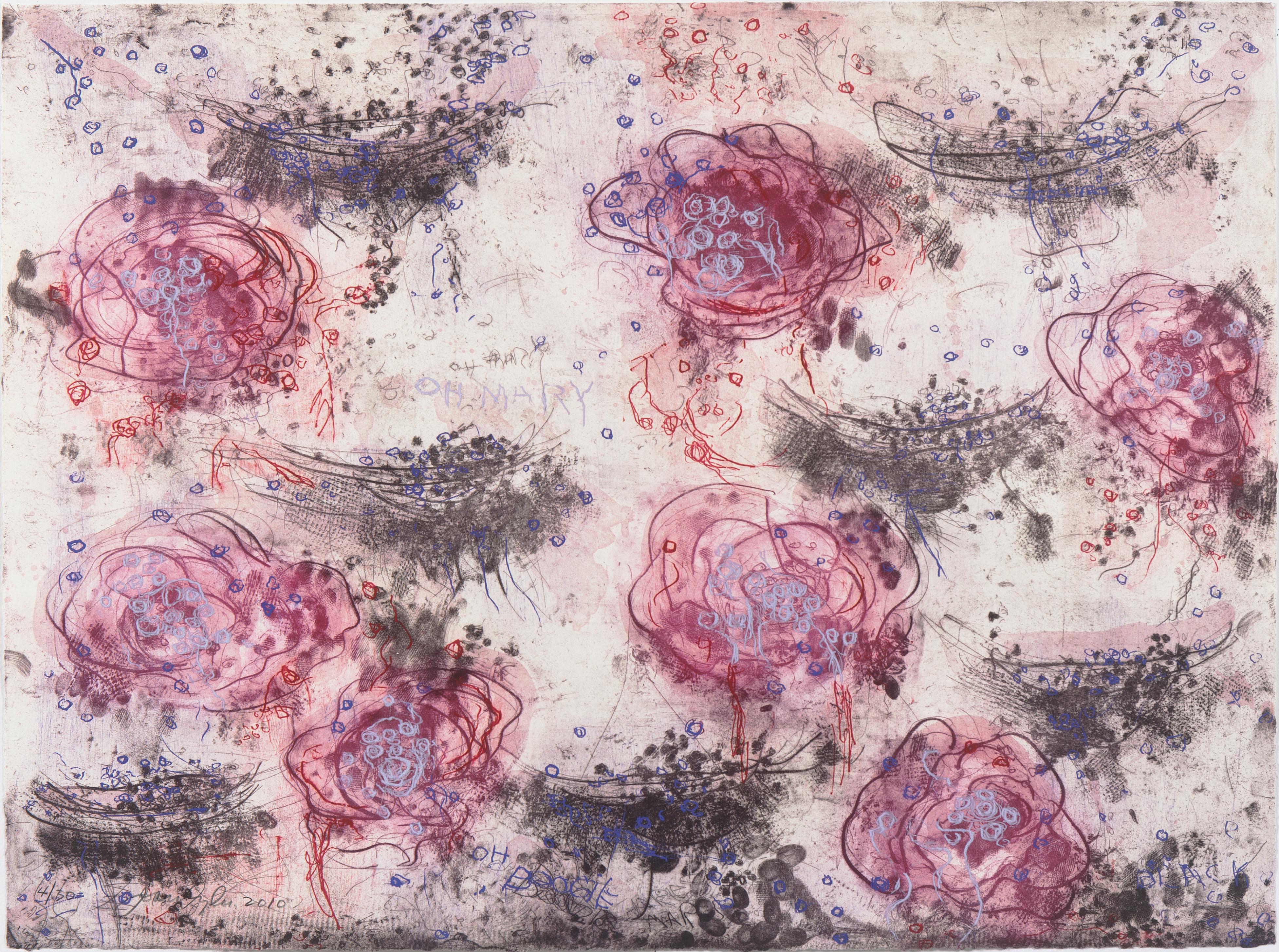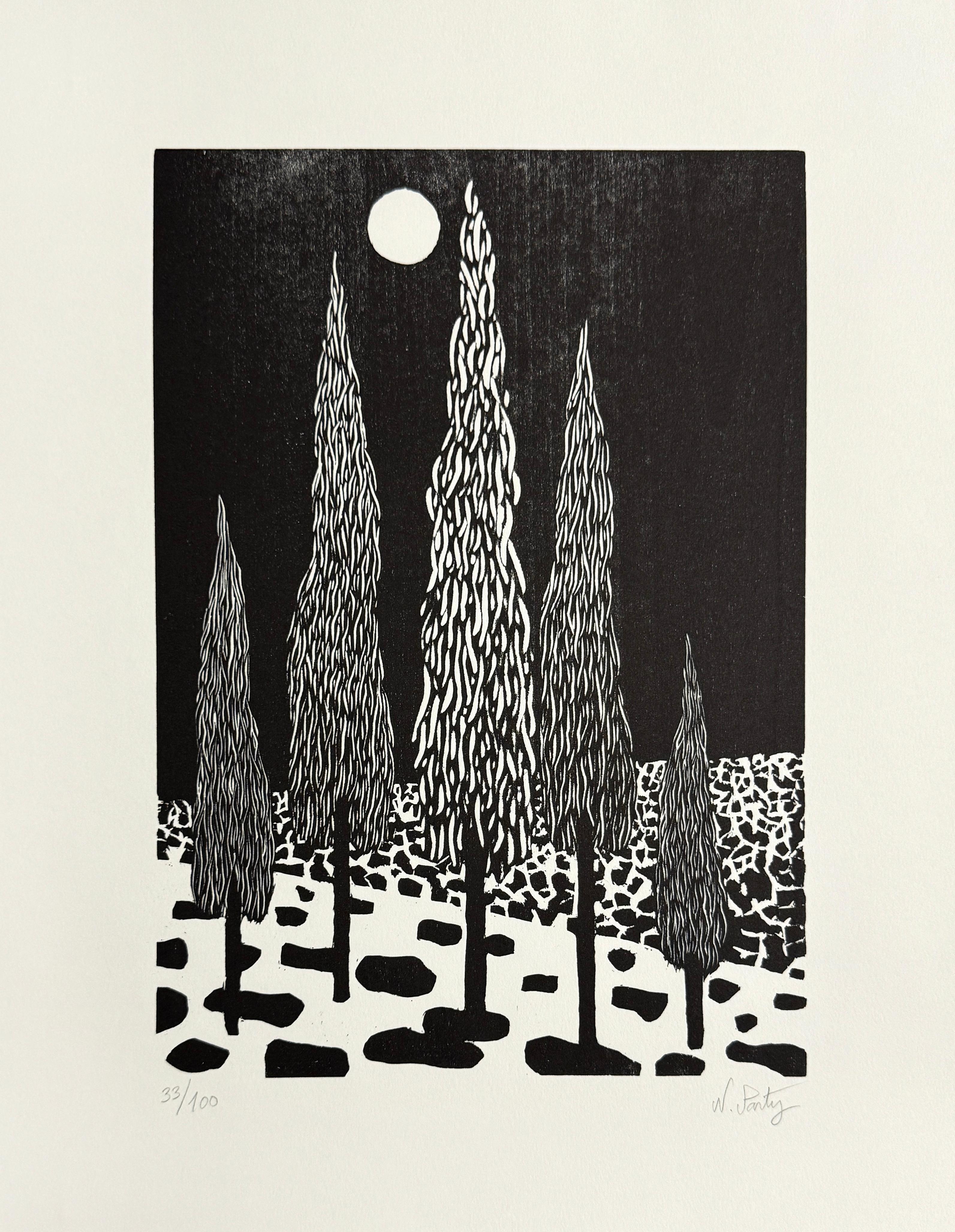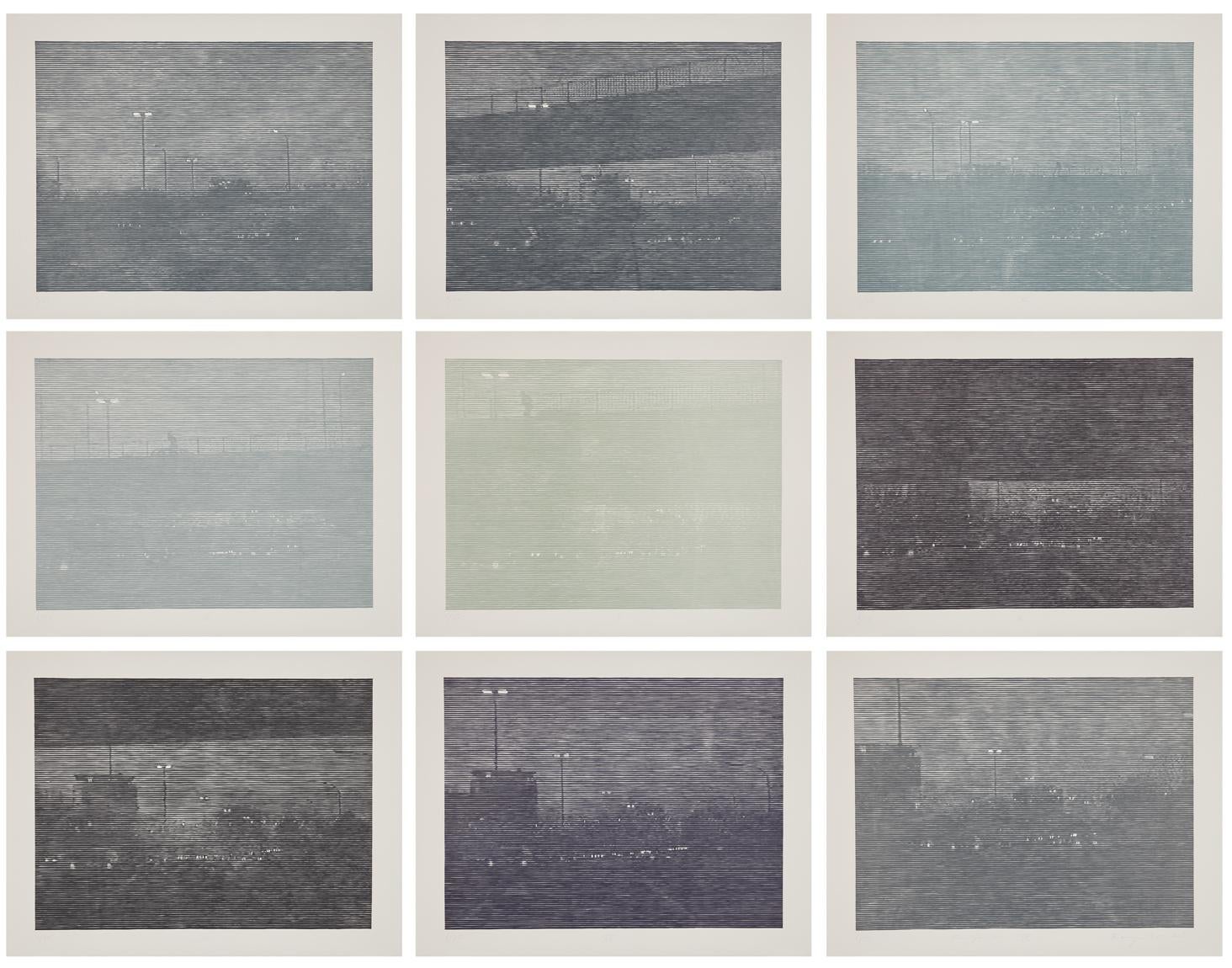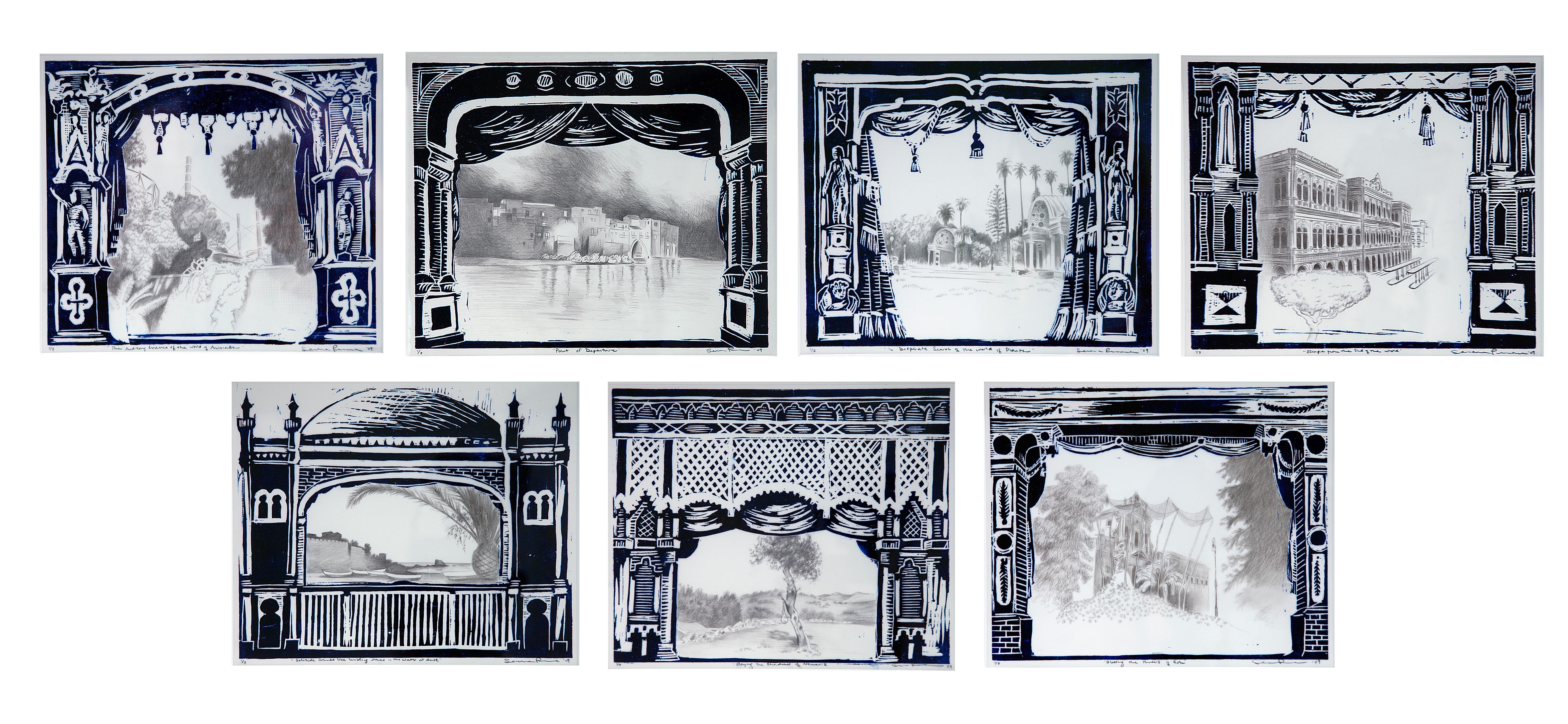Items Similar to 'Garyu no sakura' (The Lying Dragon Cherry Tree, Gifu) — Contemporary Japanese
Want more images or videos?
Request additional images or videos from the seller
1 of 6
Hajime Namiki'Garyu no sakura' (The Lying Dragon Cherry Tree, Gifu) — Contemporary Japanese2003
2003
About the Item
Hajime Namiki, 'Garyu no sakura (The Lying Dragon Cherry Tree, Gifu)', color woodcut, 2003, edition 200. Signed in pencil and with the artist’s red seal. Numbered '110/200' and titled in Japanese, in pencil. A very fine impression with strong, fresh colors, on heavy, white wove paper; the full sheet with margins (1 1/2 to 1 3/4 inches), in excellent condition. Image size 16 X 31 inches (406 X 787 mm); sheet size 19 1/4 x 34 inches (489 x 864 mm). Archivally sleeved, unmatted.
In this work, Namiki employs an especially beautiful and unusual use of color; the very delicate white and pinks of the cherry blossoms contrast dramatically with the rich grays of the gnarled tree trunk and the orange-brown earth. The sky, printed in a reflective silver that graduates to a warm, pale bronze toward the ground, changes with the ambient light and the viewer‘s position, rendering a dramatic representation of the qualities of a living tree in nature.
A depiction of the famous cherry tree of Gifu prefecture, which has been designated a Japanese natural monument. Named 'Garyu no sakura', 'The Lying Dragon Cherry Tree' because its shape resembles a lying dragon. The beloved tree is said to be more than 1100 years old and measures 15 meters high, with a trunk of 7.3 meters around.
ABOUT THE ARTIST
Contemporary master printmaker Hajime Namiki was born in 1947 in Tokyo. Originally trained as a sculptor, he began creating woodblock prints in 1978. He carves his own blocks and prints each work himself using traditional methods. His beautiful prints are often printed on a gold or silver leaf laid over Torinoko paper. Namiki uses oil-based paints rather than the more typical water-based colors, affording his works an uncommon richness and depth.
Namiki finds inspiration in nature, creating luminous, contemplative works that demonstrate a true reverence for the natural world around him. Long fascinated by the delicacy and majesty of trees, he has masterfully captured their subtle beauty in his unique modern style.
Namiki has exhibited his woodblocks widely throughout Japan and internationally. He has shown regularly at the annual College Women's Association of Japan Print Show in Tokyo, an international showcase for Japanese contemporary prints. His works are included in the collections of the White House, the Los Angeles County Museum of Art, the Art Institute of Chicago, and the New Orleans Museum of Art.
- Creator:Hajime Namiki (1947, Japanese)
- Creation Year:2003
- Dimensions:Height: 31 in (78.74 cm)Width: 16 in (40.64 cm)
- Medium:
- Movement & Style:
- Period:
- Condition:
- Gallery Location:Myrtle Beach, SC
- Reference Number:
About the Seller
5.0
Recognized Seller
These prestigious sellers are industry leaders and represent the highest echelon for item quality and design.
Platinum Seller
These expertly vetted sellers are 1stDibs' most experienced sellers and are rated highest by our customers.
Established in 1995
1stDibs seller since 2016
254 sales on 1stDibs
Typical response time: 1 hour
Associations
International Fine Print Dealers Association
- ShippingRetrieving quote...Ships From: Myrtle Beach, SC
- Return PolicyA return for this item may be initiated within 7 days of delivery.
More From This SellerView All
- 'Hill' — 1930s American ModernismBy Paul LandacreLocated in Myrtle Beach, SCPaul Landacre, 'Hill', wood engraving, 1936, edition 60 (only 54 printed); only 2 impressions printed in a second edition of 150. Signed, titled, and numbered '49/60' in pencil. Wien...Category
1930s American Modern Landscape Prints
MaterialsWoodcut
- 'Taos Placita' — 1940s Southwest RegionalismBy Gustave BaumannLocated in Myrtle Beach, SCGustave Baumann, 'Taos Placita', color woodcut, 1947, edition 125. Baumann 132. Signed, titled, and numbered '20-125' in pencil; with the artist’s Hand-in-Heart chop. A superb, richly-inked impression, with fresh colors, on fibrous oatmeal wove paper; the full sheet with margins (2 to 3 1/8 inches); slight rippling at the left sheet edge, in excellent condition. Matted to museum standards, unframed. Image size 9 5/8 x 11 1/4 inches (244 x 286 mm); sheet size 13 1/4 x 17 inches (337 x 432 mm). Collections: New Mexico Museum of Art, Phoenix Art Museum, Wichita Art Museum. ABOUT THE ARTIST Gustave Baumann (1881-1971) was a renowned printmaker and a leading figure of the American color woodcut revival whose exquisite craftsmanship and vibrant imagery captured the essence of the Southwest. "A brilliant printmaker, Baumann brought to the medium a full mastery of the craft of woodworking that he acquired from his father, a German cabinetmaker. This craftsmanship was coupled with a strong artistic training that resulted in the handsome objects we see in the exhibition today. After discovering New Mexico in 1918, Baumann began to explore in his woodblock prints of this period the light. color, and architectural forms of that landscape. His prints of this period are among the most beautiful and poetic images of the American West." —Lewis I. Sharp, Director, Denver Art Museum Baumann, the son of a craftsman, immigrated to the United States from Germany with his family when he was ten, settling in Chicago. From 1897 to 1904, he studied in the evenings at the Art Institute of Chicago, working in a commercial printmaking shop during the day. In 1905, he returned to Germany to attend the Kunstwerbe Schule in Munich, where he decided on a career in printmaking. He returned to Chicago in 1906 and worked for a few years as a graphic designer of labels. Baumann made his first prints in 1909 and exhibited them at the Art Institute of Chicago the following year. In 1910, he moved to the artists’ colony in Nashville, Indiana, where he explored the creative and commercial possibilities of a career as a printmaker. In 1915, he exhibited his color woodcuts at the Panama-Pacific International Exposition in San Francisco, winning the gold medal. Among Baumann’s ongoing commercial activities was his work for the Packard Motor Car Company from 1914 to 1920 where he produced designs, illustrations, and color woodcuts until 1923. In 1919, Baumann’s printmaking work dominated the important exhibition of American color woodcuts at the Detroit Institute of Arts. Twenty-six of his prints were included, far more than the works of any other artist. A set of his blocks, a preparatory drawing, and seven progressive proofs complemented the exhibition. That same year, Baumann worked in New York and, over the summer, in Provincetown, Massachusetts. His airy images of Cape Cod employed soft, pastel colors and occasionally showed the influence of the white-line woodcut technique. Many of his Chicago artist friends had traveled to the southwest, and Baumann became intrigued by their paintings, souvenirs, and stories of an exotic place named Taos, New Mexico. In the summer of 1918, he spent the summer in Taos sketching and painting before visiting Santa Fe. Paul Walter, the director of the Museum of New Mexico, offered him a studio in the museum's basement. Inspired by the rugged beauty of the Southwest—the vibrant colors and dramatic landscapes of the region became a central theme in his work, influencing his artistic style and subject matter for the remainder of his career. Later in the decade, he traveled to the West Coast and made prints of California landscape. Baumann's prints became synonymous with the Southwest, capturing the spirit of its place in America's identity with a unique sense of authenticity and reverence. His iconic images of desert vistas, pueblo villages, and indigenous cultures served as visual tributes to the region's rich cultural heritage, earning him a dedicated following among collectors and curators alike. A true craftsman and artist, Baumann completed every step of the printmaking process himself, cutting each block, mixing the inks, and printing every impression on the handmade paper he selected. His dedication to true craftsmanship and his commitment to preserving the integrity of his artistic vision earned him widespread acclaim and recognition within the art world. About the vibrant colors he produced, Baumann stated, “A knowledge of color needs to be acquired since they don’t all behave the same way when ground or mixed...careful chemistry goes into the making of colors, with meticulous testing for permanence. While complicated formulae evolve new colors, those derived from Earth and metal bases are still the most reliable.” In the 1930s, Baumann became interested in puppet theater. He designed and carved his own marionettes and established a little traveling company. From 1943 to 1945, the artist carved an altarpiece for the Episcopal Church of the Holy Faith in Santa Fe. In 1952, a retrospective exhibition of his prints was mounted at the New Mexico Museum of Fine Arts. Throughout his prolific career, Baumann executed nearly four hundred color woodcuts. Baumann’s woodcuts...Category
1940s American Modern Landscape Prints
MaterialsWoodcut
- Kintai Bridge at Iwakuni in Suo Province (Suo iwakuni kintai-bashi), 1859By Hiroshige IILocated in Myrtle Beach, SCUtagawa Hiroshige II (1829-1869), 'Kintai Bridge at Iwakuni in Suo Province' (Suo iwakuni kintai-bashi), from the series 'One Hundred Views of Famous Pla...Category
1850s Edo Landscape Prints
MaterialsWoodcut
- 'Laguna Cove' — 1930s American ModernismBy Paul LandacreLocated in Myrtle Beach, SCPaul Landacre, 'Laguna Cove', wood engraving, 1935; edition 60 (16 printed), 2nd edition 150 (6 printed), Woodcut Society 200, Wien 247. Signed and titled in pencil. A brilliant, black impression, on cream wove Japan, with full margins (3/4 to 1 3/4 inches), in excellent condition. Archivally matted to museum standards, unframed. This impression is from the edition published for the Twentieth Presentation Print of the Woodcut Society, 1941. Printed by Torch Press, Cedar Rapids. Literature: Reproduced in 'James Swann...Category
1930s American Modern Landscape Prints
MaterialsWoodcut
- 'Chion-in Temple Gate' from 'Eight Scenes of Cherry Blossoms' — Jizuri SealBy Hiroshi YoshidaLocated in Myrtle Beach, SCHiroshi Yoshida, 'Chion-in Temple Gate (Sunset)' from the series 'Eight Scenes of Cherry Blossoms (Sakura hachi dai: Sakura mon)', color woodblock print, 1935. Signed in brush 'Yoshida' and in pencil 'Hiroshi Yoshida'. A superb, early impression, with fresh colors; the full sheet with margins, on cream Japan paper; an area of slight toning in the top right sheet corner, not affecting the image, otherwise in excellent condition. Marked with a jizuri (self-printed) seal, upper left margin. Self-published by the artist. Image size 9 5/8 x 14 3/4 inches (444 x 375 mm); sheet size 10 7/8 x 16 inches (276 x 406 mm). Archivally sleeved, unmatted. Provenance: M. Nakazawa, Tokyo. Literature: Japanese Landscapes of the 20th century (Hotei Publishing calendar), 2001, May. Collections: Honolulu Museum of Art, Museum of Fine Arts, Boston. ABOUT THE IMAGE Located in Kyoto, Chionin is the main temple of the Jodo sect of Japanese Buddhism, one of the most popular Buddhist sects in Japan, having millions of followers. The Sanmon Gate, Chionin's entrance gate, standing 24 meters tall and 50 meters wide, it is the largest wooden temple gate in Japan and dates back to the early 1600s. Behind the gate, a wide set of stairs leads to the main temple grounds. ABOUT THE ARTIST Painter and printmaker Yoshida Hiroshi (1876-1950) is regarded as one of the greatest artists of the Japanese 'shin hanga' (New Print) movement. Yoshida was born as the second son of Ueda Tsukane in Kurume, Fukuoka Prefecture, a schoolteacher from an old samurai family. In 1891 he was adopted by his art teacher Yoshida Kasaburo in Fukuoka and took his surname. In 1893 he went to Kyoto to study painting, and the following year to Tokyo to join Koyama Shotaro's Fudosha private school; he also became a member of the Meiji Fine Arts Society. These institutions taught and advocated Western-style painting, greatly influencing Yoshida’s artistic development. In 1899 Yoshida had his first American exhibition at Detroit Museum of Art (now Detroit Institute of Art), making the first of many visits to the US and Europe. In 1902 he helped reorganize the Meiji Fine Arts Society, renaming it the Taiheiyo-Gakai (Pacific Painting...Category
1930s Showa Figurative Prints
MaterialsWoodcut
- The Beach at Kaiganji in Sanuki Province — Lifetime Impression, 1934By Kawase HasuiLocated in Myrtle Beach, SCThe Beach at Kaiganji in Sanuki Province (Sanuki Kaiganji no hama), from the series Collected Views of Japan II, Kansai Edition (Nihon fûkei shû II Kansai hen), woodblock print, 1934. A very fine, atmospheric impression, with fresh colors; the full sheet, in excellent condition. Signed 'Hasui' with the artist’s seal 'Kawase', lower left. Published by Watanabe Shozaburo with the Watanabe ‘D’ seal indicating an early impression printed between 1931 - 1941. Stamped faintly 'Made in Japan' in the bottom center margin, verso. Horizontal ôban; image size 9 3/8 x 14 1/4 inches (238 x 362 mm); sheet size approximately 10 5/16 x 15 1/2 inches ( 262 x 394 mm). Collections: Art Institute of Chicago; Austrian Museum of Applied Arts (Vienna); Honolulu Museum of Art; Museum of Fine Arts, Boston; National Museum in Warsaw; University of Wisconsin-Madison. ABOUT THE ARTIST “I do not paint subjective impressions. My work is based on reality...I can not falsify...(but) I can simplify…I make mental impressions of the light and color at the time of sketching. While coloring the sketch, I am already imagining the effects in a woodblock print.” — Kawase Hasui Hasui Kawase...Category
1930s Showa Landscape Prints
MaterialsWoodcut
You May Also Like
- Wild RosesBy Joan SnyderLocated in Brooklyn, NYWild Roses, 2010 Lithograph/etching/woodcut 28 3/8 × 38 3/8 in 72.1 × 97.5 cm This print combines etching, lithography, and woodcut to create a great variet...Category
2010s Contemporary Landscape Prints
MaterialsEtching, Lithograph, Woodcut
- TreesBy Nicolas PartyLocated in London, GBWoodcut on BFK Rives paper, produced in 2020. Edition of 100. Mint condition, unframed. Signed and numbered in pencil by Nicolas Party.Category
2010s Contemporary Landscape Prints
MaterialsWoodcut
- "Nachtfahrt"By Christiane BaumgartnerLocated in Köln, DEA wonderful and delicate portfolio by Christiane Baumgartner, artist from Leipzig/Germany. "Nachtfahrt" (night tour) consists of 9 woodcut prints on Zerkall laid paper. Each work has...Category
Early 2000s Contemporary Landscape Prints
MaterialsWoodcut
- Fictive HomelandsLocated in Providence, RIFictive Homelands is a suite of 7 woodcut prints with silverpoint drawing on mylar by artist Serena Perrone. Fictive Homelands is a series of works that use the theater proscenium ...Category
Early 2000s Contemporary Landscape Prints
MaterialsSilver
- "Thicket 6" - Multi-layered Branches and Foliage in Orange Yellow BlueBy Katherine WarinnerLocated in Morgan Hill, CA"Thicket 6" is a dramatic relief monotype with layers of orange foliage and branches as well as yellow and blue foliage. This print on paper is mounted onto cradled wood panel with a protective cold wax coating on the surface. In her creative process, Katherine scans organic material which she then refines into digital files. The images are then then cut out of wood using a laser cutter. Katherine prints the inked wood shapes in combination with cyanotype photograms, in different arrangements making each print unique. For more works by Katherine Warriner and new listings, follow our storefront at Colibri Gallery. Katherine Warinner...Category
2010s Contemporary Abstract Prints
MaterialsMonotype, Woodcut
- "Thicket 4" - Multi-layered Branches and Foliage in Yellow Green BlueBy Katherine WarinnerLocated in Morgan Hill, CA"Thicket 4" is a dramatic relief monotype with layers of orange, green, and blue foliage and branches. The overlapping translucent layers create a multitude of addition colors, shapes, and a rich depth. This print on paper is mounted onto cradled wood panel with a protective cold wax coating on the surface. In her creative process, Katherine scans organic material which she then refines into digital files. The images are then then cut out of wood using a laser cutter. Katherine prints the inked wood shapes in combination with cyanotype photograms, in different arrangements making each print unique. For more works by Katherine Warriner and new listings, follow our storefront at Colibri Gallery. Katherine Warinner...Category
2010s Contemporary Abstract Prints
MaterialsMonotype, Woodcut
Recently Viewed
View AllMore Ways To Browse
Japanese Sculptor
Cherry And Gold
Cherry Trees
Japanese Block Art
Japanese Print Gold
Japanese Dragon
Dragon Japan
Japanese Cherry
Japanese Bronze Old
Woodblock Prints Contemporary
Tree Trunk Art
Print Of Cherries
Japaneses Block Print
Japanese Block Prints
Japanese Color Woodblock Print
Japan Cherry Blossoms
Japanese Cherry Blossoms
Tree Trunk Base



